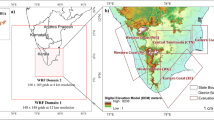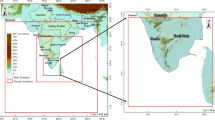Abstract
On 21 July 2012, an extreme rainfall event that recorded a maximum rainfall amount over 24 hours of 460 mm, occurred in Bei**g, China. Most operational models failed to predict such an extreme amount. In this study, a convective-permitting ensemble forecast system (CEFS), at 4-km grid spacing, covering the entire mainland of China, is applied to this extreme rainfall case. CEFS consists of 22 members and uses multiple physics parameterizations. For the event, the predicted maximum is 415 mm d-1 in the probability-matched ensemble mean. The predicted high-probability heavy rain region is located in southwest Bei**g, as was observed. Ensemble-based verification scores are then investigated. For a small verification domain covering Bei**g and its surrounding areas, the precipitation rank histogram of CEFS is much flatter than that of a reference global ensemble. CEFS has a lower (higher) Brier score and a higher resolution than the global ensemble for precipitation, indicating more reliable probabilistic forecasting by CEFS. Additionally, forecasts of different ensemble members are compared and discussed. Most of the extreme rainfall comes from convection in the warm sector east of an approaching cold front. A few members of CEFS successfully reproduce such precipitation, and orographic lift of highly moist low-level flows with a significantly southeasterly component is suggested to have played important roles in producing the initial convection. Comparisons between good and bad forecast members indicate a strong sensitivity of the extreme rainfall to the mesoscale environmental conditions, and, to less of an extent, the model physics.
Similar content being viewed by others
References
Bowler, N. E., A. Arribas, K. R. Mylne, K. B. Robertson, and S. E. Beare, 2008: The MOGREPS short-range ensemble prediction system. Quart. J. Roy. Meteor. Soc., 134, 703–722.
Brown, B. G., J. H. Gotway, R. Bullock, E. Gilleland, and D. Ahijevych, 2009: The model evaluation tools (MET): Community tools for forecast evaluation. Proc. 25th Conf. Int. Inter-active Information and Processing Systems (IIPS) for Meteorology, Oceanography, and Hydrology, Phoenix, AZ, US., American Meteorological Society, Paper 9A.6.
Buizza, R., and A. Hollingsworth, 2002: Storm prediction over Europe using the ECMWF ensemble prediction system. Meteorological Applications, 9, 289–305.
Buizza, R., D. S. Richardson, and T. N. Palmer, 2003: Benefits of increased resolution in the ECMWF ensemble system and comparison with Poor-man’s ensembles. Quart. J. Roy. Meteor. Soc., 129, 1269–1288.
Charles, M. E., and B. A. Colle, 2009: Verification of extratropical cyclones within the NCEP operational models. Part II: The short-range ensemble forecast system. Wea. Forecasting, 24, 1191–1214.
Chen, Y., J. Sun, J. Xu, S. N. Yagn, Z. P. Zong, T. Chen, C. Fang and J. Sheng, 2012: Analysis and thinking on the extremes of the 21 July 2012 torrential rain in Bei**g Part I: Observation and thinking. Meteorological Monthly, 38, 1255–1266. (in Chinese)
Clark, A. J., W. A. Gallus, M. Xue, and F. Y. Kong, 2009: A comparison of precipitation forecast skill between small convection-allowing and large convection-parameterizing ensembles. Wea. Forecasting, 24, 1121–1140.
Clark, A. J., and Coauthors, 2012: An overview of the 2010 hazardous weather testbed experimental forecast program spring experiment. Bull. Amer. Meteor. Soc., 93, 55–74.
Doswell, C. A., H. E. Brooks, and R. A. Maddox, 1996: Flash flood forecasting: An ingredients-based methodology. Wea. Forecasting, 11, 560–581.
Du, J., S. L. Mullen, and F. Sanders, 1997: Short-range ensemble forecasting of quantitative precipitation. Mon.Wea. Rev., 125, 2427–2459.
Ebert, E. E., 2001: Ability of a poor man’s ensemble to predict the probability and distribution of precipitation. Mon. Wea. Rev., 129, 2461–2480.
Fan, S. Y., M. Chen, J. Q. Zhong, and Z. F. Zheng, 2009: Performance tests and evaluations of Bei**g local high-resolution rapid update cycle system. Torrential Rain and Disasters, 28, 119–125. (in Chinese)
Fels, S. B., and M. D. Schwarzkopf, 1975: The simplified exchange approximation: A new method for radiative transfer calculations. J. Atmos. Sci., 32, 1476–1488.
Hamill, T. M., 2001: Interpretation of rank histograms for verifying ensemble forecasts. Mon. Wea. Rev., 129, 550.
Hamill, T. M., R. Hagedorn, and J. S. Whitaker, 2008: Probabilistic forecast calibration using ECMWF and GFS ensemble reforecasts. Part II: Precipitation. Mon. Wea. Rev., 136, 2620–2632.
Houtekamer, P. L., L. Lefaivre, J. Derome, H. Ritchie, and H. L. Mitchell, 1996: A system simulation approach to ensemble prediction. Mon. Wea. Rev., 124, 1225–1242.
Iyer, E. R., A. J. Clark, M. Xue, and F. Y. Kong, 2016: A comparison of 36-60-h precipitation forecasts from convectionallowing and convection-parameterizing ensembles. Wea. Forecasting, 31, 647–661.
Jiang, X. M., H. L. Yuan, M. Xue, X. Chen, and X. G. Tan, 2014: Analysis of a torrential rainfall event over Bei**g on 21–22 July 2012 based on high resolution model analyses and forecasts. Acta Meteorologica Sinica, 72, 207–219.
Kong, F. Y., K. K. Droegemeier, and N. L. Hickmon, 2007: Multiresolution ensemble forecasts of an observed tornadic thunderstorm system. Part II: Storm-scale experiments. Mon.Wea. Rev., 135, 759–782.
Kong, F. Y., and Coauthors, 2008: Real-time storm-scale ensemble forecast 2008 spring experiment. Proc. 24th Conf. Severe Local Storms, Savannah, GA, Amer. Meteor. Soc., Paper 12.13.
Kong, F. Y., and Coauthors, 2014: An overview of CAPS storm-scale ensemble forecast for the 2014 NOAA HWT spring forecasting experiment. Proc. 27th Conf. Severe Local Storms, Madison WI, Amer. Meteor. Soc., Paper 43.
Li, J., J. Du, and Y. Liu, 2015: A comparison of initial condition-, multi-physics- and stochastic physics-based ensembles in predicting Bei**g “7.21” excessive storm rain event. Acta Meteorologica Sinica, 73, 50–71. (in Chinese)
Liu, Y. Z., X. S. Shen, and X. L. Li, 2013: Research on the singular vector perturbation of the GRAPES global model based on the total energy norm. Acta Meteorologica Sinica, 71, 517–526. (in Chinese)
Molteni, F., R. Buizza, T. N. Palmer, and T. Petroliagis, 1996: The ECMWF ensemble prediction system: methodology and validation. Quart. J. Roy. Meteor. Soc., 122, 73–119.
Murphy, A. H., 1973: A new vector partition of the probability score. J. Appl. Meteor., 12, 595–600.
Palmer, T. N., F. Molteni, R. Mureau, R. Buizza, P. Chapelet, and J. Tribbia, 1993: Ensemble Prediction. ECMWF Seminar Proceedings on Validation of Models over Europe, Vol. I., Reading, U.K., ECMWF, 21–66.
Pellerin, G., L. Lefaivre, P. Houtekamer, and C. Girard, 2003: Increasing the horizontal resolution of ensemble forecasts at CMC. Nonlinear Processes in Geophysics, 10, 463–468.
Pleim, J. E., 2006: A simple, efficient solution of flux–profile relationships in the atmospheric surface layer. J. Appl. Meteor. Climatol., 45, 341–347.
Pleim, J. E., 2007: A combined local and nonlocal closure model for the atmospheric boundary layer. Part I: Model description and testing. J. Appl. Meteor. Climatol., 46, 1383–1395.
Pleim, J. E., and A. J. **u, 1995: Development and testing of a surface flux and planetary boundary layer model for application in mesoscale models. J. Appl. Meteor., 34, 16–32.
Ren, Z., J. Chen, and H. Tian, 2011: Research on T213 ensemble prediction system stochastic physics perturbation. Meteorological Monthly, 37, 1049–1059. (in Chinese)
Ritchie, H., and C. Beaudoin, 1994: Approximations and sensitivity experiments with a baroclinic semi-Lagrangian spectral model. Mon. Wea. Rev., 122, 2391–2399.
Schwartz, C. S., and Coauthors, 2009: Next-day convectionallowing WRF model guidance: A second look at 2-km versus 4-km grid spacing. Mon. Wea. Rev., 137, 3351–3372.
Skamarock, W. C., J. B. Klemp, J. Dudhia, D. O. Gill, D. M. Barker, W. Wang, and J. G. Powers, 2005: A Description of the Advanced Research WRF Version 2. NCAR Technical Note NCAR/TN–468+STR, 88 pp.
Stephenson, D. B., C. A. S. Coelho, and I. T. Jolliffe, 2008: Two extra components in the brier score decomposition. Wea. Forecasting, 23, 752–757.
Tao, W.-K., J. Simpson, and M. McCumber, 1989: An ice-water saturation adjustment. Mon. Wea. Rev., 117, 231–235.
Tao, Z. Y., and Y. G. Zheng, 2013: Forecasting issues of the extreme heavy rain in Bei**g on 21 July 2012. Torrential Rain and Disasters, 32, 193–201. (in Chinese)
Theis, S. E., A. Hense, and U. Damrath, 2005: Probabilistic precipitation forecasts from a deterministic model: a pragmatic approach. Meteorological Applications, 12, 257–268.
Toth, Z., and E. Kalnay, 1993: Ensemble forecasting at NMC: The generation of perturbations. Bull. Amer. Meteor. Soc., 74, 2317–2330.
Toth, Z., and E. Kalnay, 1997: Ensemble forecasting at NCEP and the breeding method. Mon. Wea. Rev., 125, 3297–3319.
Wen, Y. R., L. Xue, Y. Li, N. Wei, and A. M. Lü, 2015: Interaction between typhoon Vicente (1208) and the Western Pacific subtropical high during the Bei**g extreme rainfall of 21 July 2012. J. Meteor. Res., 29, 293–304.
Whitaker, J. S., T. M. Hamill, X. Wei, Y. C. Song, and Z. Toth, 2008: Ensemble data assimilation with the NCEP global forecast system. Mon. Wea. Rev., 136, 463–482.
Xue, M., F. Y. Kong, K. W. Thomas, J. D. Gao, Y. H. Wang, K. A. Brewster and K. K. Droegemeier, 2013: Prediction of convective storms at convection-resolving 1 km resolution over continental United States with radar data assimilation: An example case of 26 May 2008 and precipitation forecasts from spring 2009. Advances in Meteorology, 2013, Article ID 259052, doi: 10.1155/2013/259052.
Xue, M., and Coauthors, 2007: CAPS realtime storm-scale ensemble and high-resolution forecasts as part of the NOAA Hazardous Weather Testbed 2007 spring experiment. 22nd Conf. Weather Analysis and Forecasting and 18th Conf. Numerical Weather Prediction, Park City, UT, Amer. Meteor. Soc., CDROM 3B. 1.
Xue, M., and Coauthors, 2011: CAPS realtime storm scale ensemble and high resolution forecasts for the NOAA hazardous weather testbed 2010 spring experiment. 24th Conf. Weather Forecasting and 20th Conf. Numerical Weather Prediction, Seattle, WA, Amer. Meteor. Soc., Paper 9A.2.
Yu, H. Z., and Z. Y. Meng, 2016: Key synoptic-scale features influencing the high-impact heavy rainfall in Bei**g, China, on 21 July 2012. Tellus A, 68, 31045.
Yu, X. D., 2012: Investigation of Bei**g extreme flooding event on 21 July 2012. Meteorological Monthly, 38, 1313–1329. (in Chinese)
Zhang, D. L., Y. H. Lin, P. Zhao, X. D. Yu, S. Q. Wang, H. W. Kang, and Y. H. Ding, 2013: The Bei**g extreme rainfall of 21 July 2012: “Right results” but for wrong reasons. Geophys. Res. Lett., 40, 1426–1431.
Zhang, H. B., J. Chen, X. F. Zhi, Y. L. Li, and Y. Sun, 2014: Study on the application of GRAPES regional ensemble prediction system. Meteorological Monthly, 40, 1076–1087. (in Chinese)
Zhong, L. Z., R. Mu, D. L. Zhang, P. Zhao, Z. Q. Zhang, and N. Wang, 2015: An observational analysis of warm-sector rainfall characteristics associated with the 21 July 2012 Bei**g extreme rainfall event. J. Geophys. Res., 120, 3274–3291.
Zhu, K. F., Y. Yang, and M. Xue, 2015: Percentile-based neighborhood precipitation verification and its application to a landfalling tropical storm case with radar data assimilation. Adv. Atmos. Sci., 32, 1449–1459, doi: 10.1007/s00376-015-5023-9.
Author information
Authors and Affiliations
Corresponding author
Rights and permissions
About this article
Cite this article
Zhu, K., Xue, M. Evaluation of WRF-based convection-permitting multi-physics ensemble forecasts over China for an extreme rainfall event on 21 July 2012 in Bei**g. Adv. Atmos. Sci. 33, 1240–1258 (2016). https://doi.org/10.1007/s00376-016-6202-z
Received:
Revised:
Accepted:
Published:
Issue Date:
DOI: https://doi.org/10.1007/s00376-016-6202-z




